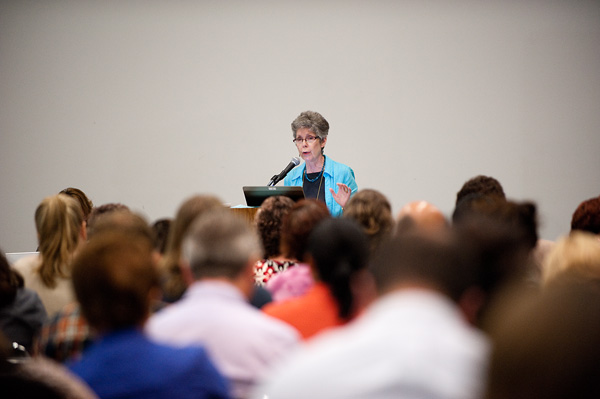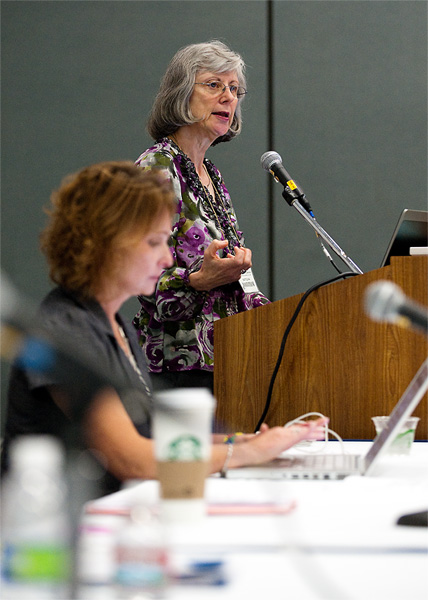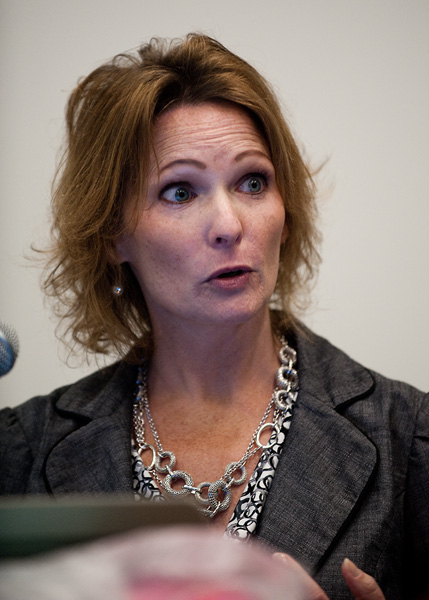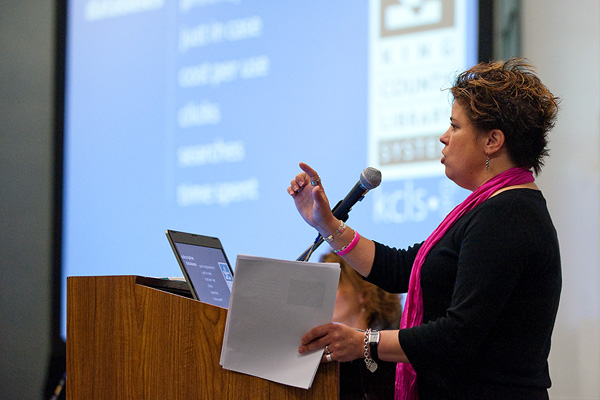
Ann Silvers Lee. Photo: Dave Feiling Photography
For ebooks, “true collection development is going to have to wait…until we have more access, if not all access to everything that’s being published,” Anne Silvers Lee, chief of the materials management division of the Free Library of Philadelphia, said during a Saturday panel discussion at the American Library Association‘s annual conference in Anaheim this weekend.
Her point was a theme that resonated throughout “The Ebook Elephant in the Room: Determining What’s Relevant and Effective for Your Patrons & Making Effective Decisions for Your Future E-collection” session. The popularity of ebooks continues to grow, yet many major publishers remain reluctant to sell ebooks to libraries. Meanwhile, the variety of content licensing, ownership, and lending models continues to proliferate. It is difficult terrain to navigate, and collection development librarians aren’t entirely in the driver’s seat.
Fortunately, as panel moderator and Library Journal Book Review editor Heather A. McCormack noted, the situation seems to be improving. Watching the evolution of the major players’ attitudes during the past three years, she said, “I think librarians, for their part have gone along the lines of, ‘why us?’ to ‘we’re scared,’ to ‘we’re screwed,’ to ‘we’re angry,’ to today, which is along the lines of ‘we can do this. We can innovate, we can collaborate, we can lobby.’”

Linda Di Biase. Photo: Dave Feiling Photography
McCormack and Silvers Lee were joined by Linda Di Biase, collection development librarian, University of Washington Libraries, Seattle, Sue Polanka, head of reference and instruction for the University Libraries, Wright State University, and Alene Moroni, manager, selection and order, for King County Library System. Their presentations covered a variety of aspects of ebook collection development, ranging from selecting a business model to work with, to finding ways to pay for a growing collection, to the benefits of patron-driven and demand-driven acquisition.
Polanka began her portion of the presentation by noting that “rule number one with collection development: when it comes to ebooks, you’re not just buying content. No longer can you just decide, ‘I would like this book.’ You have to buy content wrapped in a container; you have to buy content wrapped in software.”
This new model has significant implications. Libraries must choose an interface that patrons are comfortable with, content that is affordable and compatible with that interface, and vendors with whom they believe they can establish sustainable business relationships.

Sue Polanka. Photo: Dave Feiling Photography
As librarians approach this challenge, Polanka suggested that they begin by thinking through their prime directive and deciding what kind of collection they want to have, since choosing specific content will often dictate which vendors are available, what the interface will look like, and what the licensing terms will be.
“If your mission is to build the most comprehensive collection no matter what…you have to buy your books in one way. If instead, you decide, that’s not my mission…I want to spend my money so that I can provide the most access to the most people to get them the content they want just in time, then you need to look at a completely different business model.”
Polanka noted that current business models present a spectrum of accessibility. On one end, there are public domain and open access ebooks. On the other end are arrangements that offer libraries short term loans or rentals of content for users. In the center are perpetual access models, including licensing arrangements with no fees, fees paid up front, or perpetual access with ongoing fees.
Progressing along that spectrum from public domain content to short term rental models, digital rights management software becomes more pervasive and restrictive, and there is a higher risk that the content will disappear from a library’s collection if a subscription lapses or if a vendor or publisher changes their terms. So, if building a permanent collection of ebooks is a library’s primary goal, open access and public domain works would build the best foundation; if maximum access to the most ebooks is a library’s goal, a system that uses short term rentals would be the best solution.
Polanka shared her experience with the Ohio Library and Information Network (OhioLINK), a consortium of 91 Academic libraries serving 700,000 users, which began owning and hosting electronic journals beginning in 2000, and later began acquiring ebooks. OhioLINK now has 41,000 titles—more than Project Gutenberg, Polanka noted. These titles are DRM-free, and allow unlimited simultaneous use, and unlimited lifetime use across the state for all members of the consortium.
There are drawbacks, however. The open source software that houses the content can be difficult and time consuming to use, and its user interface “isn’t as nice” as most publisher platforms. There is also no way for users to download content to e-readers at the current time. But, the consortium still owns the content, and platform enhancements could potentially resolve those issues down the road.
Finding Funding

Alene Moroni. Photo: Dave Feiling Photography
Regardless of which ebook business model a library chooses to work with, there are always costs involved, and with acquisition budgets flat or declining at many libraries, building a new collection in this rapidly growing area poses a separate set of funding challenges.
KCLS serves a population of 1.3 million, and enjoys heavy use and support from their community in Seattle, circulating more than 22 million items annually. Moroni said that KCLS has been working with ebooks since 2003, but in recent years, demand has grown quickly. During the past three years, their ebook budget has grown by 60% every year, even as KCLS has dealt with a relatively flat budget.
“Those of you in public libraries know, when something new comes along you don’t get to stop buying any of the other things that you’ve been buying,” Moroni said, offering the VHS to DVD transition as an example.
“It’s the same thing with books. You don’t get to stop buying books, we just have to add ebooks.”
Instead, KCLS took a hard look at their print reference collection, and started by shifting a portion of that funding over to downloadable content. More recently, this past year, they began a bigger shift, cutting their electronic database budget by 50% and moving that money—almost half a million dollars—into downloadable content.
To decide what got cut, usage statistics were collected, staff were surveyed regarding how patrons were using these resources, and a scoring system was developed based on KCLS’s public services plan. As electronic journals have come up for subscription renewal, those with low usage, duplication with a print resource, or high level of overlap within a subject area are considered for elimination, and staff are prepared to suggest alternatives. Moroni did note that one cut led to sufficient complaints for KCLS to renew the resource after cancellation, but the majority of the cuts have not caused any patron complaints.
Demand Driven Acquisition
Patron Driven Acquisition (PDA) and Demand Driven Acquisition (DDA), while posing a their own set of challenges, have become ways for libraries to ensure that their ebook funds are being spent on content that users want.
Students and instructors in the University of Washington system already had access to about half a million ebooks, including collections such as 18th Century Collections Online. Triennial surveys indicated a high level of user satisfaction, but, as Di Biase noted “the survey isn’t specific enough to answer the kind of questions that we want to have answers to regarding the ebook content that we put up…We wanted to gain knowledge of what our patrons really wanted to use.”
So, from July 2010 through February 2011, the University of Washington tried its first PDA pilot program with ebrary, focusing on titles in the humanities and social sciences, using $40,000 in gift and endowment funds. Ten different activities would trigger the purchase of an ebook, including printing or copying from the book, or reading for a certain period of time. A $150 cap was set on the price, and while purchased books had to have a publication date between 2005 and 2010, no attempt was made to screen for print duplication within the library’s holdings.
Throughout the process, ebrary provided weekly reports comparing PDA ebook purchases with print holdings, and examining the last circulation date of those print copies.
After the conclusion of the pilot program, the library examined the percentage of titles purchased, titles that were used but not purchased, and titles that were never used, and compared the percentage of titles available versus the percentage of titles purchased by subject, to identify high- and low-use subjects.
They found that a high percentage—59 percent—of ebooks purchased through PDA were also owned in print. While 17% of those titles were unavailable for checkout, 42% were owned and available for checkout in print, but apparently, patrons preferred the ebook version. The post-pilot analysis also found higher than average purchases in history, economics, sociology, and political science.
The University of Washington has also been working on two DDA projects. The first is an ongoing Ebook Library (EBL) DDA started in April 2011 with a $37,000 budget using a short-term loan model. When 3 patrons check out the ebook on short term loan, it triggers a purchase, as long as the publication date is 2007 or later. Again, there has been no effort to screen for print duplication.
The second is a consortial DDA project with the 37-member Orbis Cascade Alliance of academic libraries. That pilot began in July 2011 with EBL and Baker & Taylor‘s YBP services. $462,000 has been budgeted through collections from all members for fiscal 2012. There, a $250 price cap per book has been set, ebooks must have a publication date of 2009 or later, and 10 short-term loans lead to a purchase, which all libraries in the consortium then own.
Di Biase said that some of the smaller institutions initially expressed concern about how applicable some books would be to their collections if the books were selected by users from larger libraries. But, ultimately, most purchases have been triggered by use from at least three separate institutions. And the project has worked out well. So far, 100 percent of titles selected via DDA have been used again within a year of being purchased.
The Digital Divide
Of course, as Silvers Lee noted, true collection development with ebooks won’t be possible until libraries and their patrons can select from all available ebook content. And other challenges remain. Notably, in many library systems, a large percentage of patrons still lack Internet access.
“We hear that term [the digital divide] tossed about, and often it can mean generational differences…but in Philadelphia, what we mean by the digital divide is something a little bit different, and it may be in your area as well. We have a number of studies done over the years, and most recently a Pew Charitable Trust poll that suggest that fully 40% of Philadelphia residents do not have Internet access at home.”
Access to smartphones is starting to help bridge that divide among lower-income households, which is why mobile apps are becoming an increasingly important topic of conversation with vendors.
“In Philadelphia and maybe where you are, we have to think about how we respond to that. And that does tie back to our mission, about not focusing so narrowly on one group of users, in this case talking about ebook users like they are the only people who are using us. So we know that we need to step back and think about an e-resource approach that does combine ebooks, does combine those subscription databases that we continue to have…and also a mobile library website that acts as a portal.”


